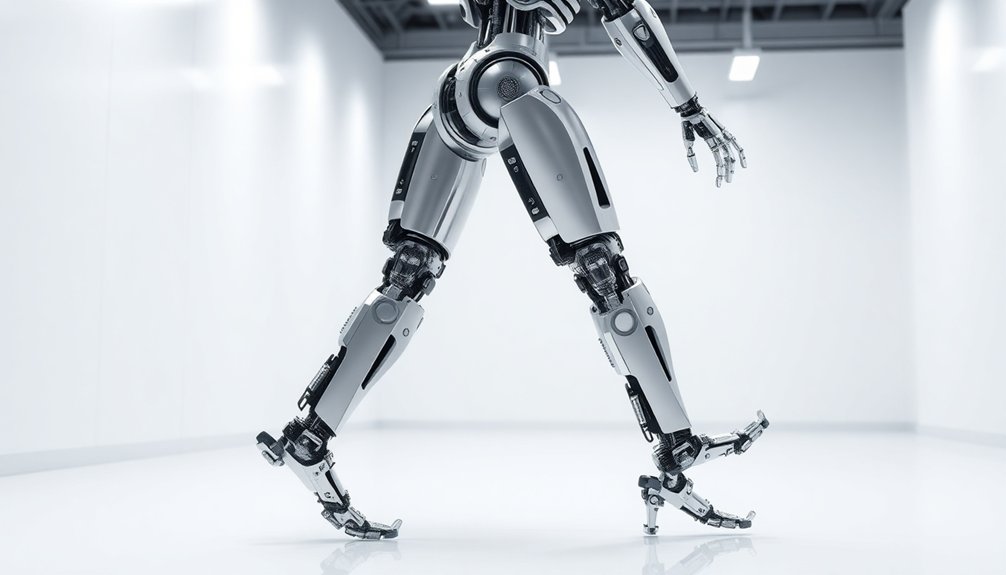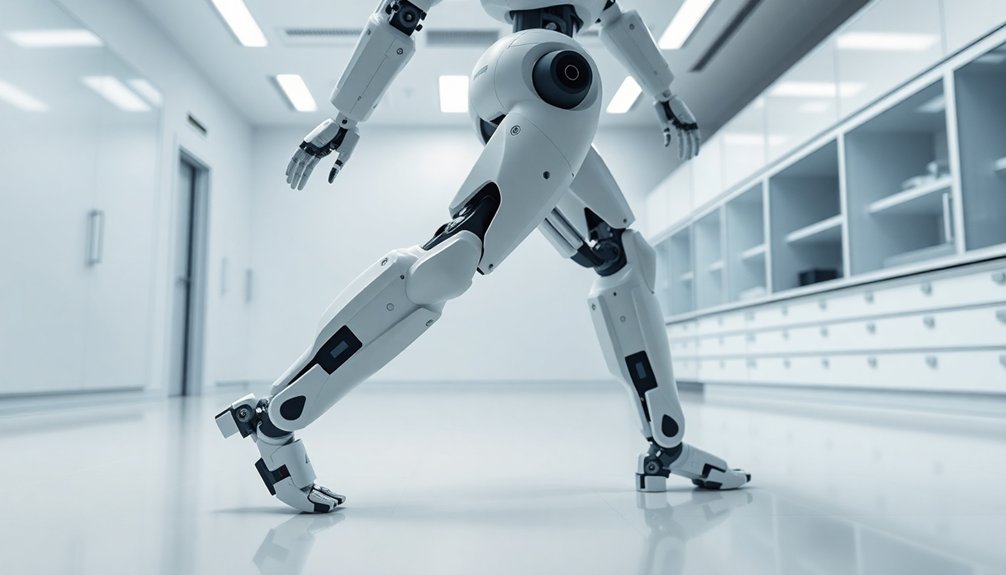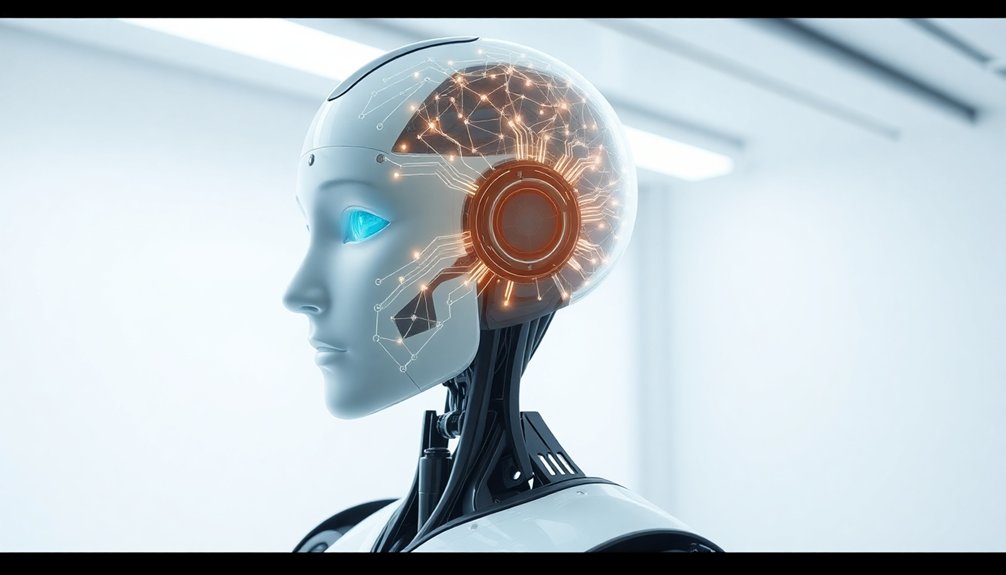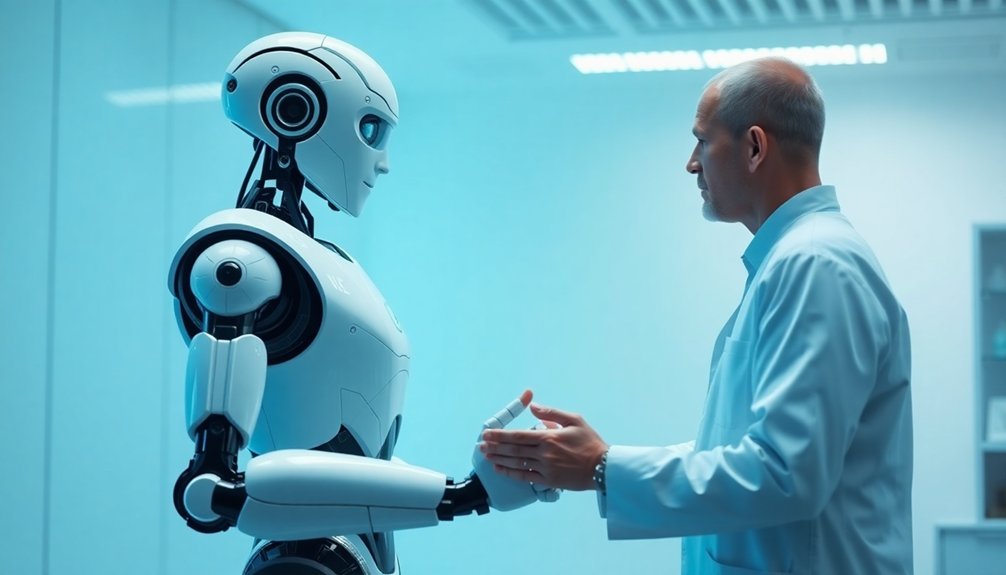A humanoid robot isn’t just metal and circuits—it’s a high-tech mirror of human design. You’ll find these machines sport human-like anatomy with sensors that see, hear, and feel, actuators that move like muscles, and AI brains that learn and adapt. They’re not just programmed; they’re thinking machines that can grip delicate objects, recognize emotions, and collaborate with humans. Curious about how they’ll reshape our world? Stick around.
Mechanical Structure: Mimicking Human Anatomy

While human anatomy might seem like a perfect blueprint, creating a robot that mimics our complex physical structure is no small feat. Humanoid robots aren’t just fancy metal dolls—they’re intricate machines designed to replicate our movements with shocking precision.
The mechanical structure starts with a core that stabilizes everything, just like our spine. Arms and hands get packed with actuators and sensors, letting robots grab objects and perform delicate tasks. Their legs enable bipedal locomotion, using smart algorithms to balance and walk across different terrains.
Lightweight materials make these robots flexible, almost dance-like in their mobility. Think of them as high-tech cousins of human anatomy—capable of traversing our world with an uncanny resemblance to how we move, interact, and explore. Bipedal robot systems leverage advanced control mechanisms to ensure precise balance and natural human-like movement across various environments.
Sensor Systems: Eyes, Ears, and Touch of a Robot
Imagine a robot that can actually “see” the world around it—not just scan, but truly perceive. These high-tech sensors aren’t just hardware; they’re the robot’s nervous system.
Visual data streams in through cameras and LiDAR, creating 3D maps that help navigate complex spaces. Tactile sensors in robotic hands aren’t just cool tech—they’re precision instruments that measure grip strength and enable delicate interactions.
But here’s where it gets wild: AI transforms raw sensory input into real-world understanding, processing environmental cues faster than you can blink. Machine learning algorithms enable robots to enhance their sensory adaptability and insight, bridging the gap between human intuition and robotic intelligence.
Want proof of adaptability? These robots can adjust movements mid-action, interpreting subtle changes in their surroundings. It’s like giving a machine human-level awareness—minus the existential crisis.
Who decides where the line between machine and intelligent being really sits? The sensors do.
Actuators and Motion: How Robots Generate Movement

Ever wondered how robots move without looking like they’re having a seizure? Actuators are the secret sauce, fundamentally robotic muscles that let humanoid machines generate precise, biomimetic movements that make engineers weak in the knees.
You’ll be amazed how these mechanical marvels can mimic human joint control with algorithms so smart they make your smartphone look like a pocket calculator.
Muscle-Like Motion Mechanics
Because robots don’t magically float around like sci-fi holograms, they need muscle-like systems to actually move. Actuators in humanoid robots are the secret sauce of muscle-like motion mechanics, transforming electrical signals into physical actions.
Here’s how they work:
- Electric motors provide versatile movement, adjusting speed and force like biological muscles.
- Pneumatic actuators deliver high-power performance in lightweight robot designs.
- Tendon-driven systems mimic human muscle actions, enabling delicate object manipulation.
- Real-time feedback mechanisms dynamically adjust complex movements for stability and balance.
These mechanical muscles aren’t just rigid pistons—they’re sophisticated systems that let robots walk, grasp, and interact with environments.
Want to make a robot move? You’ll need smart actuators that can translate digital commands into smooth, precise physical actions. It’s less “Terminator” and more “helpful assistant with impressive coordination.”
Precision Joint Control
From muscle-like mechanics to the intricate ballet of robotic movement, precision joint control is where the magic happens. Your robotic arms aren’t just metal and wires—they’re sophisticated dancers choreographed by advanced algorithms and high-tech sensors.
These mechanical marvels use cutting-edge actuators that translate complex instructions into smooth, human-like flexibility. Imagine tiny machines constantly adjusting, compensating, minimizing friction, and maximizing performance.
Each joint is a marvel of engineering, designed to mimic human anatomy while surpassing biological limitations. Precision isn’t just a goal; it’s the fundamental language of robotic motion.
High-strength materials and microscopic manufacturing techniques guarantee your robot moves with surgical accuracy, turning mechanical potential into kinetic poetry. Who said robots can’t be graceful?
Biomimetic Movement Strategies
When engineers decided robots should move more like us and less like clunky machines, biomimetic movement strategies emerged as the coolest kid in mechanical engineering.
Humanoid robots now navigate complex environments using advanced actuators that mimic human muscle movements. Their evolution centers on creating more natural, adaptive motion:
- Sophisticated algorithms enable bipedal locomotion, allowing robots to balance on uneven surfaces like nimble tightrope walkers.
- Tendon-driven systems in robotic hands replicate delicate human finger movements with precision.
- Machine learning helps robots adapt their movement strategies based on real-time sensory feedback.
- Electric, pneumatic, and hydraulic actuators provide varying strength levels for different motion requirements.
These biomimetic approaches transform robots from rigid metal constructs into dynamic, responsive machines that can think and move with increasing human-like fluidity.
Who said robots can’t dance?
Cognitive Architectures: The Brain Behind the Mechanics

As if plucking intelligence from thin air, cognitive architectures transform humanoid robots from mere mechanical puppets into thinking machines. These brain-like systems aren’t just wiring and code—they’re sophisticated decision-making engines that process sensory data with lightning speed.
You’ll find learning architectures that let robots adapt to new tasks faster than you can say “artificial intelligence,” turning complex robotics into something almost magical.
Imagine a robot that doesn’t just react, but predicts. Model-based reflexive architectures use historical data to estimate environmental states, while deliberative systems can evaluate potential actions before moving.
They’re not just following programmed instructions; they’re strategizing, learning, and evolving. It’s like giving a machine a brain that’s part calculator, part chess grandmaster, and part curious toddler.
Learning and Adaptation: From Programmed to Intelligent
You’ve seen robots follow programmed instructions, but machine learning is transforming them from rigid automatons into adaptive problem-solvers that can actually learn from their mistakes.
Imagine a robot that doesn’t just repeat tasks, but figures out new approaches in real-time, improving its performance through sophisticated AI algorithms that mimic how humans learn and adjust.
These intelligent systems aren’t just following a script anymore—they’re developing their own strategies, processing complex sensory data, and becoming more flexible with every interaction.
Machine Learning Mastery
Because traditional robots used to be nothing more than rigid, pre-programmed machines, machine learning has transformed humanoid robots into something extraordinary.
Now, robots use sophisticated machine learning algorithms that let them:
- Learn from sensory data and autonomously improve their skills
- Apply reinforcement learning to master complex tasks through trial and error
- Recognize environmental changes and adapt to new situations instantly
- Adjust interactions with humans in real-time using AI and robotics techniques
Imagine a robot that can delicately handle a fragile wine glass or navigate unpredictable terrain without explicit programming.
These aren’t sci-fi fantasies anymore—they’re happening right now. Machine learning has fundamentally given robots a brain that can think, learn, and evolve.
Who would’ve thought metal and code could become so… intelligent?
Adaptive Robotic Intelligence
While traditional robots once mindlessly followed rigid instructions, adaptive robotic intelligence represents a quantum leap in machine capabilities. With Artificial Intelligence, robots move beyond programmed routines, learning and adjusting through sophisticated machine learning algorithms.
| Capability | Impact |
|---|---|
| Sensors | Interpret complex environmental data |
| Learning | Adapt without manual reprogramming |
| Cognitive Architecture | Support dynamic decision-making |
Your humanoid companion now learns from experience, mimicking human anatomy’s adaptive strategies. Proprioceptive and visual sensors help robots fine-tune movements, enabling them to handle delicate objects with precision. They’re not just machines anymore—they’re intelligent systems that evolve, improve, and surprise you. Think of them as curious apprentices constantly refining their skills, transforming from rigid automatons into flexible, responsive intelligences that can navigate unpredictable environments with remarkable agility.
Human-Robot Interaction: Communication and Collaboration

As humanoid robots evolve, they’re transforming how we interact and collaborate in ways that once seemed like science fiction. These intelligent machines are breaking down communication barriers through cutting-edge technologies:
- Gesture Recognition: Robots now read human movements like digital mind readers, responding to subtle signals with uncanny precision.
- Emotional Sensors: Advanced AI decodes your mood, allowing robots to react with surprising empathy.
- Multimodal Communication: Combining voice, gestures, and contextual understanding for more natural interactions.
- Safety Protocols: Built-in features guarantee these mechanical companions won’t accidentally turn you into a cautionary tale.
Imagine working alongside a robot that understands your frustration, anticipates your needs, and collaborates seamlessly.
A robotic partner sensing your emotional landscape, predicting challenges, and syncing perfectly with human workflow.
Humanoid robots aren’t just machines; they’re becoming sophisticated partners that blur the lines between technology and human connection.
Future Horizons: Emerging Technologies in Humanoid Robotics
The robots that once seemed like clunky sci-fi props are quickly morphing into something far more impressive—intelligent companions ready to reshape our world. As technology advances, humanoid robots rely on cutting-edge AI to make decisions and adapt to complex environments.
| Technology | Impact |
|---|---|
| 5G | Real-time communication |
| Machine Learning | Adaptive problem-solving |
| Fuel Cell Systems | Extended operational time |
| Gesture Recognition | Enhanced human interaction |
| Collaborative Design | Workplace safety integration |
Imagine a robot that can learn from its mistakes and improve continuously. Collaborative robots are no longer just industrial tools—they’re becoming sophisticated partners in healthcare, logistics, and customer service. The future isn’t about replacing humans; it’s about creating intelligent systems that complement our capabilities, pushing the boundaries of what’s possible in real-world applications.
Frequently Asked Questions
What Makes a Robot Humanoid?
Like a mirror reflecting human potential, you’ll recognize a humanoid robot by its human-like body structure, bipedal movement, sensors mimicking perception, and intelligent systems that enable adaptive learning and task-specific interactions.
What Are the 5 Major Components of a Robot?
You’ll find a humanoid robot’s 5 major components are: head (intelligence), torso (core systems), arms/hands (task precision), legs/feet (mobility), and sensor-AI array (perception and decision-making).
What Makes a Robot Intelligent?
You’ll find a robot intelligent when it can process sensor data, learn from experiences, make autonomous decisions, adapt to changing environments, and interact meaningfully through advanced AI algorithms and machine learning techniques.
What Are the Key Components of Humanoid Robots?
You’ll blend mechanical precision with human-like design: head sensors, torso processors, articulated arms, and balanced legs. These components interact dynamically, transforming cold metal into a machine that mimics human movement and interaction capabilities.
Final Thoughts
You’re standing at the edge of a robot revolution. By 2030, humanoid robots could represent a $38 billion market – that’s not sci-fi, that’s economics. They’re getting smarter, more agile, and weirdly more human-like every day. Will they replace us? Probably not. But they’ll definitely change how we work, interact, and understand intelligence. The future isn’t about robots taking over; it’s about robots working alongside us, learning, adapting, and pushing the boundaries of what’s possible.
